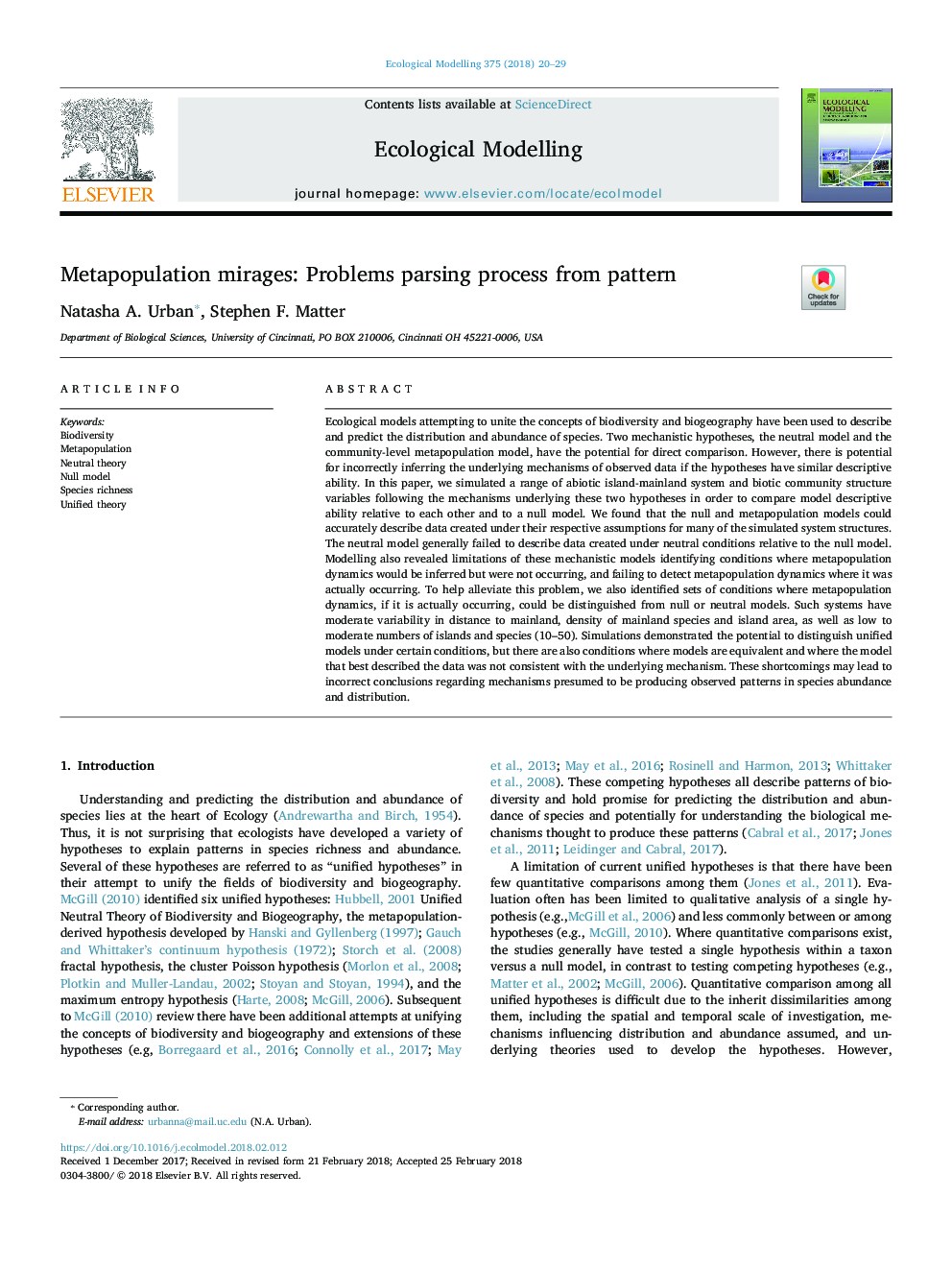| کد مقاله | کد نشریه | سال انتشار | مقاله انگلیسی | نسخه تمام متن |
|---|---|---|---|---|
| 8846070 | 1617372 | 2018 | 10 صفحه PDF | دانلود رایگان |
عنوان انگلیسی مقاله ISI
Metapopulation mirages: Problems parsing process from pattern
ترجمه فارسی عنوان
معبد متاپولاتور: مشکل پردازش تجزیه از الگوی
دانلود مقاله + سفارش ترجمه
دانلود مقاله ISI انگلیسی
رایگان برای ایرانیان
کلمات کلیدی
ترجمه چکیده
برای توصیف و پیش بینی توزیع و فراوانی گونه ها، مدل های اکولوژیکی تلاش می کنند تا مفاهیم تنوع زیستی و بیوگرافی را متحد کنند. دو فرضیه مکانیستیک، مدل بی طرف و مدل فراوانی جمعیت در سطح جامعه، دارای پتانسیل برای مقایسه مستقیم هستند. با این حال، اگر فرضیه ها توانایی توصیفی مشابهی داشته باشند، پتانسیل نادرست به ارزیابی مکانیسم های زیربنایی داده های مشاهده شده وجود دارد. در این مقاله، ما تعدادی از متغیرهای سیستم همسایگی جزیره-سرزمین اصلی و متغیرهای ساختاری جامعه بیوتیک را دنبال کردیم که به دنبال سازوکارهای زیربنایی این دو فرضیه به منظور مقایسه توانایی های توصیفی مدل نسبت به یکدیگر و به یک مدل صفر است. ما دریافتیم که مدلهای صفر و متا آپوپاتی میتوانند اطلاعاتی را که در زیر مفروضات مربوطه برای بسیاری از ساختارهای سیستم شبیه سازی شده ایجاد شده، دقیقا توصیف کنند. مدل خنثی به طور کلی قادر به توصیف داده های ایجاد شده در شرایط خنثی نسبت به مدل صفر نیست. مدل سازی نیز محدودیت های این مدل های مکانیستی را شناسایی کرده است که در آن پویایی متاپول پتانسیل به دست می آید اما اتفاق نمی افتد و ناکامی در تشخیص پویایی متاوپولوله ای که در واقع رخ می دهد، وجود دارد. برای کمک به حل این مشکل، ما همچنین مجموعه ای از شرایط را که در آن دینامیک متاوپولیزاسیون، اگر در واقع رخ می دهد، از مدل های صفر یا خنثی شناسایی کنیم. چنین سیستمی دارای تنوع متوسطی در فاصله از سرزمین اصلی، تراکم گونه های سرزمین اصلی و منطقه جزیره، و همچنین تعداد کم و متوسط گونه های جزیره و گونه (10-50) است. شبیه سازی ها توانایی تشخیص مدل های یکپارچه را در شرایط خاص نشان داد، اما شرایطی وجود دارد که مدل ها معادل و مدل است که بهترین توصیف داده ها با سازوکار پایه سازگار نبود. این کاستی ها ممکن است منجر به نتیجه نادرستی در مورد مکانیزم هایی شود که احتمالا تولید الگوهای مشاهده شده در فراوانی و توزیع گونه ها را ایجاد می کند.
موضوعات مرتبط
علوم زیستی و بیوفناوری
علوم کشاورزی و بیولوژیک
بوم شناسی، تکامل، رفتار و سامانه شناسی
چکیده انگلیسی
Ecological models attempting to unite the concepts of biodiversity and biogeography have been used to describe and predict the distribution and abundance of species. Two mechanistic hypotheses, the neutral model and the community-level metapopulation model, have the potential for direct comparison. However, there is potential for incorrectly inferring the underlying mechanisms of observed data if the hypotheses have similar descriptive ability. In this paper, we simulated a range of abiotic island-mainland system and biotic community structure variables following the mechanisms underlying these two hypotheses in order to compare model descriptive ability relative to each other and to a null model. We found that the null and metapopulation models could accurately describe data created under their respective assumptions for many of the simulated system structures. The neutral model generally failed to describe data created under neutral conditions relative to the null model. Modelling also revealed limitations of these mechanistic models identifying conditions where metapopulation dynamics would be inferred but were not occurring, and failing to detect metapopulation dynamics where it was actually occurring. To help alleviate this problem, we also identified sets of conditions where metapopulation dynamics, if it is actually occurring, could be distinguished from null or neutral models. Such systems have moderate variability in distance to mainland, density of mainland species and island area, as well as low to moderate numbers of islands and species (10-50). Simulations demonstrated the potential to distinguish unified models under certain conditions, but there are also conditions where models are equivalent and where the model that best described the data was not consistent with the underlying mechanism. These shortcomings may lead to incorrect conclusions regarding mechanisms presumed to be producing observed patterns in species abundance and distribution.
ناشر
Database: Elsevier - ScienceDirect (ساینس دایرکت)
Journal: Ecological Modelling - Volume 375, 10 May 2018, Pages 20-29
Journal: Ecological Modelling - Volume 375, 10 May 2018, Pages 20-29
نویسندگان
Natasha A. Urban, Stephen F. Matter,
